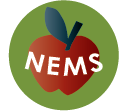The Detroit Food Map
Dr. Alex Hill, a professor at Wayne State, has an amazing website, https://detroitfoodmap.com, which incorporates his ongoing use of NEMS-S and NEMS-CS. He has been using NEMS tools for many years to track the food landscape of Detroit. His NEMS-S project, Grocery Stores as Anchors of Community Nutrition, has been testing the hypothesis that Detroit is a food desert as well as testing the reliability of food stores as access points for nutritional and healthy food options, using NEMS-S measures and GIS analysis to survey the nutritional food environment of Detroit, specifically focusing on access to healthy options in Detroit’s food system.
For his NEMS-CS project, Healthy Food in Corner Stores, it was motivated by the claim often cited that more Detroiters shop at liquor stores than at grocery stores. He knows this to be false and recent research proves it to be false. However, there is a lack of knowledge about what is available in convenience, corner, and dollar stores.
NEMS-S in the Classroom
John Hopkins Political Science Professor Adam Sheingate decided to use the NEMS-S tool with a summer class. Click here if you would like to read more about his class project.
Using NEMS-S to Study Food Access in Baton Rouge, LA.
Dr. Stephanie Broyles at the Pennington Biomedical Research Center in Baton Rouge, LA, received a grant from the American Heart Association to study children’s neighborhood food environments. Four data collectors used the NEMS-S program for tablets and visited over 550 food stores and produce markets in the parishes surrounding Baton Rouge. The data are being linked to other study data to investigate the impact of local food environments on a variety of health outcomes and behavior changes. The data have also been used to inform local food access policy within the East Baton Rouge Food Access Policy Commission’s findings and recommendations.
Presentation of NEMS-S Adaptation for Mexican Americans
Dr. Donna M. Winham presented the adaptation of the NEMS-S tool for the Mexican American population at the Experimental Biology Conference in April 2013 that she and Dr. Seline Szkupinski Quiroga collaborated on while at Arizona State University. The tool itself has not been publicly released but you can click here to view the slides on the adaptation. Dr. Winham is the owner and principal consultant at Howell Research Associates, LLC, and can be contacted at dmwinham@howellresearch.org.
Using NEMS-S in a Latino Neighborhood in Milwaukee, WI (about 45 minutes) (2012)
Stephanie Calloway and Tatiana Maida of CORE/El Centro in Milwaukee, WI trained some promotoras to collect NEMS-S data. Learn about their project and results in this webinar. If you would like to contact them to learn more, email Stephanie at stephaniec@core-elcentro.org.
If you’d like to view the webinar, click here. If you would like to read more in-depth about their project, please go to the publication page and click the NEMS-S tag, or read the article here.
Omaha’s use of NEMS-S for their WIC Project (March 12, 2010)
In the spring of 2009, Douglas County Health Department (DCHD)began a NEMS project to address childhood obesity and prepare for the new WIC food packages. They customized the NEMS-S tool to better understand the adequacy of the retail food network and its capacity system to meet the demands of the new WIC food packages. The tool captured data regarding the type of food available, number of healthy choices within a food category, cost of those choices, and quality of the fresh produce. The project initially identified 507 food outlets in the metropolitan area; 89 were eliminated as single food outlets as bakeries and butcher shops. Fifty trained community volunteers collected data in 385 retail food establishments in the metropolitan area over a one month period. Stores with multiple healthy options in each of the five groups (fruits, vegetables, dairy, protein, and grains) were mapped with a one-mile radius. The results of the survey demonstrated geographic areas where the retail food system has limited ability to meet the needs of citizens and stores whose inventory had the potential to improve their nutrition profile. Since the initial assessment was conducted, follow-ups have been done to continue to assess the changes in the food landscape.
- To listen to Mary Balluff describe the initial project, please view the webinar.
- A more detailed report of Omaha’s work can be found here.
- To view the modified NEMS-S tool used in the project (Appendix B pg. 52) along with a detailed report on the follow-up NEMS assessment, click here.
Seattle, WA (2010)
Graduate student Sara Coulter wrote her thesis on her NEMS-S data collected in a low-income racially diverse neighborhood in Seattle, WA. To read the abstract of her results, please click here. To read the entire thesis, click here.
Leon County, Florida (2010)
Angela Leone, a graduate student at UGA analyzed the NEMS data collected in Leon County, Florida. To read the abstract of her results, please click here. You can also see her publication of the results on the publications webpage, under the NEMS-S section.
